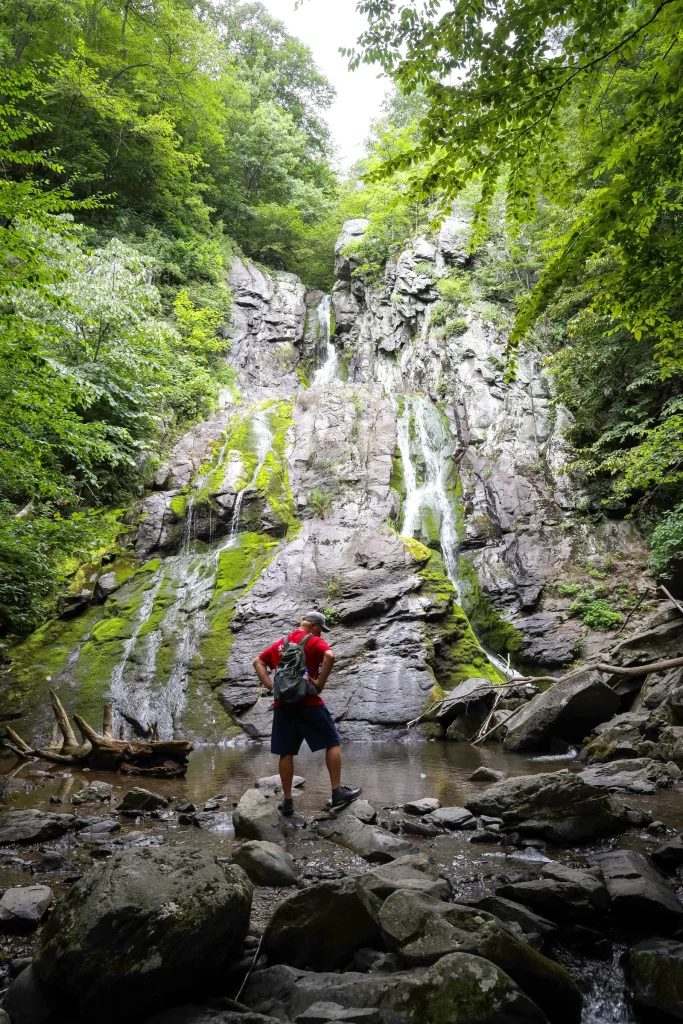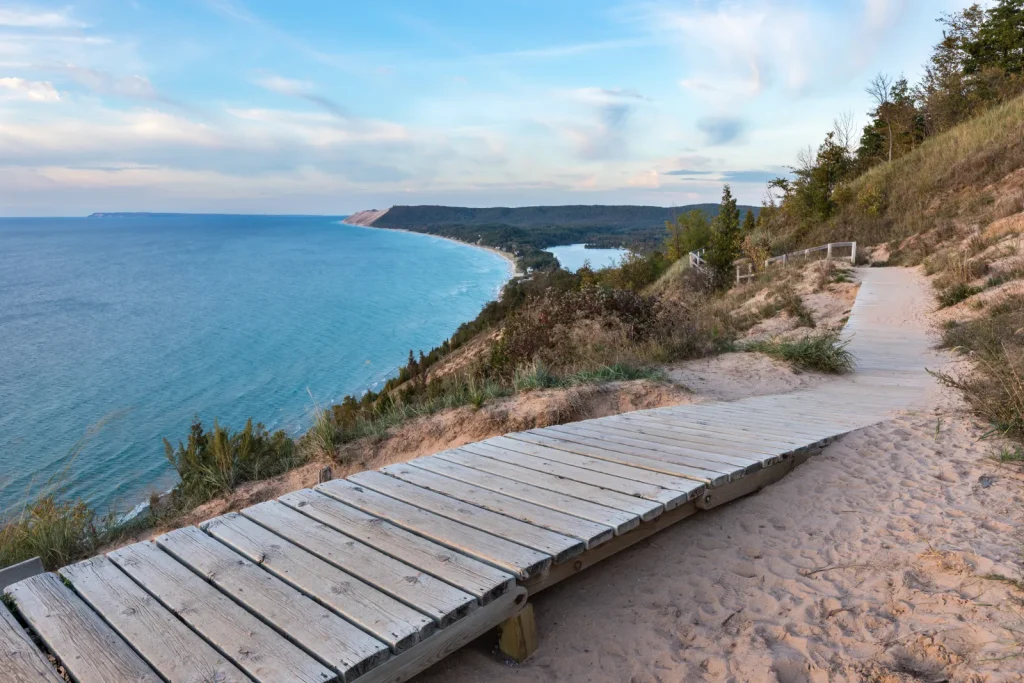Spanning across 197,439 acres, Shenandoah National Park extends through Virginia’s Blue Ridge Mountains, stretching up to 13 miles wide at certain points and narrowing to less than a mile elsewhere. Since its establishment in 1935, this expansive park has welcomed visitors with its lush rolling hills, captivating hollows, towering peaks, and enchanting waterfalls, making it one of the earliest parks established east of the Mississippi River.
Today, Shenandoah National Park draws in approximately 1.5 million visitors annually, all eager to immerse themselves in its picturesque landscapes. During the fall season, leaf enthusiasts flock from far and wide to traverse the 105-mile-long Skyline Drive, vying for prime spots at over 75 scenic overlooks and pull-offs to witness the vibrant foliage. And it’s not just humans; wildlife also calls this land home, including the iconic black bears, white-tailed deer, red foxes, raccoons, and the elusive Shenandoah salamander, found exclusively on three mountain ridges within the park. It’s no surprise that this region has a rich history dating back over 15,000 years when it served as hunting grounds for early Native American tribes. Today, the Monacan Indian Nation resides just south of the park, connecting the past with the present.
For those embarking on a journey to Shenandoah National Park, here are some tips to ensure you make the most of your experience in Virginia’s unique natural gem.
Getting there
Shenandoah National Park beckons visitors predominantly through its Front Royal entrance, situated at the northern terminus of Skyline Drive. Nestled 70 miles to the west of Washington, D.C., this gateway offers convenient access to nature enthusiasts. For those arriving by air, the park’s proximity to Washington-Dulles International Airport, just 55 miles to the east, enhances accessibility. Conversely, the Rockfish Gap entrance, positioned at the southern extremity of Skyline Drive, lies 90 miles distant from Richmond.
When is the best time to visit Shenandoah National Park?
Choosing the optimal time for a sojourn to Shenandoah National Park hinges on individual preferences and seasonal highlights. Spring brings a kaleidoscope of wildflowers, including phlox, buttercups, and trillium, which adorn hiking trails with vibrant hues. Summer envelops the landscape in lush greenery, offering respite from the sweltering lowlands with pleasantly moderate temperatures, rarely exceeding the mid-70s. The park truly shines in autumn, when swathes of golden yellow and fiery amber leaves create a picturesque panorama, attracting throngs of visitors seeking nature’s spectacle.
Winter transforms Shenandoah into a serene landscape veiled in frosty tranquility. However, this season also introduces an element of unpredictability, as inclement weather may prompt the closure of Skyline Drive to motorists. From November through February, temperatures typically hover in the 30s Fahrenheit, offering a bracing environment for those seeking solitude amidst the park’s snow-dusted trails.

The best things to do at Shenandoah National Park
Explore Shenandoah National Park by first familiarizing yourself with its three districts: north, central, and south. Each district spans approximately 30 miles, featuring designated entrances. Beginning from the north, Front Royal marks the starting point at milepost 0.6 on Skyline Drive. Moving southward, the Thornton Gap entrance sits at milepost 31.5, conveniently located west of Sperryville and east of Luray on State Route 211. Notably, it’s in close proximity to the popular Mary’s Rock hike on Skyline Drive. State Route 33 intersects Skyline Drive at the Swift Run Gap entrance, situated at milepost 65.7. Finally, the southernmost access point is the Rockfish Gap entrance at milepost 105.4, a short drive from Waynesboro where dining, wineries, and accommodations await.
For newcomers, the Dickey Ridge Visitor Center in the north district and the Harry F. Byrd, Sr. Visitor Center in the central district serve as excellent starting points. As for how long to spend in Shenandoah National Park, it ultimately hinges on the number of areas and activities you wish to experience. While some opt for a day trip to traverse Skyline Drive and tackle a couple of trails, many allocate several days for thorough exploration.
The primary draw of Shenandoah National Park is its extensive hiking opportunities, boasting over 500 miles of trails, with a notable portion being part of the renowned Appalachian Trail. Most hikes commence from trailheads along Skyline Drive, although a handful, such as the popular Old Rag trail, initiate from the park’s boundary access points.
Old Rag stands as the park’s gem; however, its popularity led to the implementation of a day-hike permit program in 2022. From March to October, all hikers are required to obtain a $1 permit, purchasable at Recreation.gov. It’s advisable to secure your pass beforehand since cell service is limited at the trailhead, and permits are not available on-site.
Along Skyline Drive, a diverse array of hiking trails cater to varying fitness levels and interests. The Fox Hollow Trail, a gentle 1.2-mile route, offers a glimpse into the park’s history, traversing former farmland owned by the Fox family, one of numerous homesteading families in the area prior to the park’s establishment. Situated across from the Dickey Ridge Visitor Center, it serves as an ideal introductory hike.
Many visitors opt for the challenge of ascending Hawksbill Summit, the park’s highest point reaching 4,051 feet in elevation. The 1.6-mile round-trip hike entails a significant elevation gain of nearly 700 feet. Additionally, the Limberlost Trail, Shenandoah’s sole fully accessible trail, meanders through a crushed gravel loop amidst low-growth forest and mountain laurel, offering an enjoyable experience for all.


Gateway Arch National Park, Missouri
When the National Park Service was established over a century ago, its primary mission revolved around the preservation of natural landscapes. However, as time progressed, the organization expanded its scope to encompass the safeguarding of sites imbued with historical, scientific, and cultural importance. Gateway Arch National Park, fondly referred to as the “Gateway to the West,” stands as a testament to this evolution, commemorating Thomas Jefferson and the intrepid pioneers who played pivotal roles in shaping America’s westward expansion.
Ensuring inclusivity and accessibility, the park has taken significant steps to accommodate visitors with mobility challenges. With the exception of the uppermost section of the arch and the higher floors of the Old Courthouse, every corner of the park is designed to be wheelchair accessible. To enhance the experience for all guests, a range of assistive devices are available, including tactile features such as a map that allows tactile exploration of the arch, pathways, and structures. Moreover, audio descriptions and visitor-controlled computer simulations are provided to enrich the exhibits and educational programs.
For those unable to ascend to the top of the arch, an innovative exhibit has been devised within the tram lobby, simulating the experience of being atop the iconic structure. This exhibit goes the extra mile by streaming a live feed from the summit, ensuring that every visitor can partake in the awe-inspiring vista.
Rapidan Camp
Discover Shenandoah National Park, where nestled within its breathtaking landscape lies Rapidan Camp, once the serene refuge of the 31st President, Herbert Hoover, amidst the turbulence of the Great Depression. Known also as Camp Hoover, this historic site comprises three meticulously restored cabins nestled along the tranquil banks of the Rapidan River: Creel Cabin, Brown House, and Prime Minister’s Cabin.
Embark on an adventure to Rapidan Camp via the scenic Mill Prong Trail or opt for a guided tour offered by the national park for a nominal fee of $10 per person. Explore the rich history and natural beauty of this iconic retreat, steeped in presidential legacy and nestled amidst the pristine wilderness of Shenandoah National Park.
Guided excursions
Explore the park’s array of activities with ranger-led programs, guided horseback riding, and exhilarating rock climbing adventures. Over 190 miles of trails, designated with yellow blazes, welcome equestrians to traverse the scenic landscapes. Opt to bring your own horse or join a guided trail ride offered by Skyland Stables from May to October. For thrill-seekers, rock climbing and rappelling await at Little Stony Man Cliffs, facilitated by Shenandoah Mountain Guides, operating between April and October.

Where to stay in Shenandoah National Park
Discover Shenandoah National Park’s array of camping and lodging options for a memorable nature retreat. The park boasts four family campgrounds open from spring to fall: Mathews Arm, Lewis Mountain, Loft Mountain, and the expansive Big Meadows, offering a grand total of 221 campsites.
In 2023, Big Meadows upgraded its convenience by introducing an online reservation system for all its campsites, simplifying the planning process for visitors. Seeking a bit more comfort? Lewis Mountain provides a range of accommodations, from climate-controlled one and two-bedroom cabins to more rustic options without running water.
For those with a taste for adventure, the park also permits primitive backcountry camping with an online permit available. (Please note that as of now, the permit form can be found on the NPS site, with plans to transition to a system on Recreation.gov).
Within Shenandoah National Park, two lodges await in the central district: Skyland and Big Meadows Lodge. The latter, a historic gem, was crafted from stone hewn from Massanutten Mountain in 1939 by the Civilian Conservation Corps. Guests at both lodges can choose from mountain lodge-style rooms or standalone cabins for a cozy stay surrounded by nature’s beauty.
Venturing beyond the park boundaries, the neighboring towns offer a variety of accommodation choices. Front Royal, situated at the park’s north end, and Waynesboro, at the south end, feature budget-friendly hotels complete with swimming pools and complimentary parking.
For a more intimate experience, consider Huntly’s Glen Gordon Manor, a charming bed-and-breakfast located just 10 miles southeast of Front Royal. This elegant manor boasts 10 luxurious rooms and suites, perfect for a tranquil escape.
Finally, near Luray, affectionately known as the “Cabin Capital of Virginia,” adventurers can choose from a selection of cabins and cottages. Luray Mountain Cabins alone offers over half a dozen cozy retreats, accommodating anywhere from two to eight people, ensuring a peaceful and private getaway in the heart of Virginia’s stunning wilderness.

Where to eat in and near Shenandoah National Park
Skyland offers two inviting dining options to satisfy any appetite. The Pollock Dining Room boasts a stunning vista of the Shenandoah Valley through its expansive windows, complemented by an elevated menu featuring dishes such as tender braised beef short ribs and flavorful venison stroganoff. Families with little ones will appreciate the “Junior Ranger” menu, catering to young adventurers. For a more laid-back experience, the Mountain Taproom is a no-frills bar and grill, hosting enjoyable family activities like trivia nights and live music. Both dining spots are available to guests from early April to late November.
At the charming Big Meadows Lodge, the Spottswood Dining Room serves up delicious, hearty comfort foods like classic meatloaf dinners and delightful mushroom ravioli. Don’t forget about your furry companions—a specially crafted canine menu offers pup-friendly dishes such as succulent roasted chicken and wholesome carrots. The lodge also boasts the cozy New Market Taproom, featuring a selection of local beers and wines to unwind with. Before you leave, be sure to treat yourself to a slice of the park’s renowned Signature Blackberry Ice Cream Pie. These dining experiences are open to visitors from late April to mid-November.
Exploring the surrounding gateway towns reveals a delightful array of culinary offerings, along with wineries and breweries to discover. In Sperryville, near the Thornton Gap entrance, take a leisurely stroll down Main Street. Stop by Before & After for scrumptious fresh-made breakfast sandwiches and paninis, or indulge in artisan pizzas at Rappahannock Pizza Kitchen, open Friday through Sunday for lunch and dinner. The options are as diverse and delightful as the natural beauty that surrounds them.
